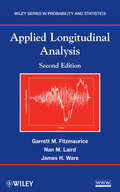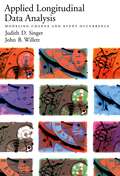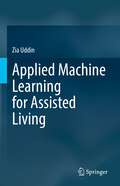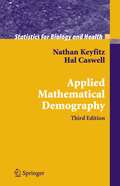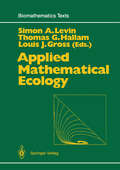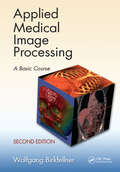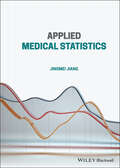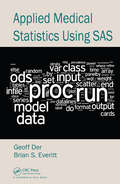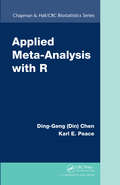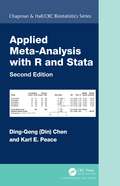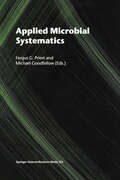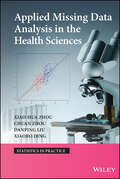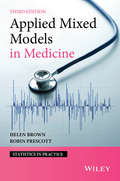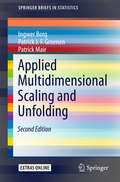- Table View
- List View
Applied Longitudinal Analysis (Wiley Series in Probability and Statistics #998)
by Garrett M. Fitzmaurice Nan M. Laird James H. WarePraise for the First Edition ". . . [this book] should be on the shelf of everyone interested in . . . longitudinal data analysis." —Journal of the American Statistical Association Features newly developed topics and applications of the analysis of longitudinal data Applied Longitudinal Analysis, Second Edition presents modern methods for analyzing data from longitudinal studies and now features the latest state-of-the-art techniques. The book emphasizes practical, rather than theoretical, aspects of methods for the analysis of diverse types of longitudinal data that can be applied across various fields of study, from the health and medical sciences to the social and behavioral sciences. The authors incorporate their extensive academic and research experience along with various updates that have been made in response to reader feedback. The Second Edition features six newly added chapters that explore topics currently evolving in the field, including: Fixed effects and mixed effects models Marginal models and generalized estimating equations Approximate methods for generalized linear mixed effects models Multiple imputation and inverse probability weighted methods Smoothing methods for longitudinal data Sample size and power Each chapter presents methods in the setting of applications to data sets drawn from the health sciences. New problem sets have been added to many chapters, and a related website features sample programs and computer output using SAS, Stata, and R, as well as data sets and supplemental slides to facilitate a complete understanding of the material. With its strong emphasis on multidisciplinary applications and the interpretation of results, Applied Longitudinal Analysis, Second Edition is an excellent book for courses on statistics in the health and medical sciences at the upper-undergraduate and graduate levels. The book also serves as a valuable reference for researchers and professionals in the medical, public health, and pharmaceutical fields as well as those in social and behavioral sciences who would like to learn more about analyzing longitudinal data.
Applied Longitudinal Data Analysis: Modeling Change and Event Occurrence
by Judith D. Singer John B. WillettChange is constant in everyday life. Infants crawl and then walk, children learn to read and write, teenagers mature in myriad ways, the elderly become frail and forgetful. Beyond these natural processes and events, external forces and interventions instigate and disrupt change: test scores may rise after a coaching course, drug abusers may remain abstinent after residential treatment. By charting changes over time and investigating whether and when events occur, researchers reveal the temporal rhythms of our lives. Applied Longitudinal Data Analysis is a much-needed professional book for empirical researchers and graduate students in the behavioral, social, and biomedical sciences. It offers the first accessible in-depth presentation of two of today's most popular statistical methods: multilevel models for individual change and hazard/survival models for event occurrence (in both discrete- and continuous-time). Using clear, concise prose and real data sets from published studies, the authors take you step by step through complete analyses, from simple exploratory displays that reveal underlying patterns through sophisticated specifications of complex statistical models. Applied Longitudinal Data Analysis offers readers a private consultation session with internationally recognized experts and represents a unique contribution to the literature on quantitative empirical methods. Visit http://www.ats.ucla.edu/stat/examples/alda.htm for: · Downloadable data sets · Library of computer programs in SAS, SPSS, Stata, HLM, MLwiN, and more · Additional material for data analysis
Applied Longitudinal Data Analysis: Modeling Change and Event Occurrence
by Judith D. Singer John B. WillettChange is constant in everyday life. Infants crawl and then walk, children learn to read and write, teenagers mature in myriad ways, the elderly become frail and forgetful. Beyond these natural processes and events, external forces and interventions instigate and disrupt change: test scores may rise after a coaching course, drug abusers may remain abstinent after residential treatment. By charting changes over time and investigating whether and when events occur, researchers reveal the temporal rhythms of our lives. Applied Longitudinal Data Analysis is a much-needed professional book for empirical researchers and graduate students in the behavioral, social, and biomedical sciences. It offers the first accessible in-depth presentation of two of today's most popular statistical methods: multilevel models for individual change and hazard/survival models for event occurrence (in both discrete- and continuous-time). Using clear, concise prose and real data sets from published studies, the authors take you step by step through complete analyses, from simple exploratory displays that reveal underlying patterns through sophisticated specifications of complex statistical models. Applied Longitudinal Data Analysis offers readers a private consultation session with internationally recognized experts and represents a unique contribution to the literature on quantitative empirical methods. Visit http://www.ats.ucla.edu/stat/examples/alda.htm for: · Downloadable data sets · Library of computer programs in SAS, SPSS, Stata, HLM, MLwiN, and more · Additional material for data analysis
Applied Machine Learning for Assisted Living
by Zia UddinUser care at home is a matter of great concern since unforeseen circumstances might occur that affect people's well-being. Technologies that assist people in independent living are essential for enhancing care in a cost-effective and reliable manner. Assisted care applications often demand real-time observation of the environment and the resident’s activities using an event-driven system. As an emerging area of research and development, it is necessary to explore the approaches of the user care system in the literature to identify current practices for future research directions. Therefore, this book is aimed at a comprehensive review of data sources (e.g., sensors) with machine learning for various smart user care systems. To encourage the readers in the field, insights of practical essence of different machine learning algorithms with sensor data (e.g., publicly available datasets) are also discussed. Some code segments are also included to motivate the researchers of the related fields to practically implement the features and machine learning techniques. It is an effort to obtain knowledge of different types of sensor-based user monitoring technologies in-home environments. With the aim of adopting these technologies, research works, and their outcomes are reported. Besides, up to date references are included for the user monitoring technologies with the aim of facilitating independent living.Research that is related to the use of user monitoring technologies in assisted living is very widespread, but it is still consists mostly of limited-scale studies. Hence, user monitoring technology is a very promising field, especially for long-term care. However, monitoring of the users for smart assisted technologies should be taken to the next level with more detailed studies that evaluate and demonstrate their potential to contribute to prolonging the independent living of people. The target of this book is to contribute towards that direction.
Applied Mathematical Ecology (Biomathematics #18)
The Second Autumn Course on Mathematical Ecology was held at the Intern ational Centre for Theoretical Physics in Trieste, Italy in November and December of 1986. During the four year period that had elapsed since the First Autumn Course on Mathematical Ecology, sufficient progress had been made in applied mathemat ical ecology to merit tilting the balance maintained between theoretical aspects and applications in the 1982 Course toward applications. The course format, while similar to that of the first Autumn Course on Mathematical Ecology, consequently focused upon applications of mathematical ecology. Current areas of application are almost as diverse as the spectrum covered by ecology. The topiys of this book reflect this diversity and were chosen because of perceived interest and utility to developing countries. Topical lectures began with foundational material mostly derived from Math ematical Ecology: An Introduction (a compilation of the lectures of the 1982 course published by Springer-Verlag in this series, Volume 17) and, when possible, progressed to the frontiers of research. In addition to the course lectures, workshops were arranged for small groups to supplement and enhance the learning experience. Other perspectives were provided through presentations by course participants and speakers at the associated Research Conference. Many of the research papers are in a companion volume, Mathematical Ecology: Proceedings Trieste 1986, published by World Scientific Press in 1988. This book is structured primarily by application area. Part II provides an introduction to mathematical and statistical applications in resource management.
Applied Medical Image Processing: A Basic Course
by Wolfgang BirkfellnerA widely used, classroom-tested text, Applied Medical Image Processing: A Basic Course delivers an ideal introduction to image processing in medicine, emphasizing the clinical relevance and special requirements of the field. Avoiding excessive mathematical formalisms, the book presents key principles by implementing algorithms from scratch and usin
Applied Medical Image Processing: A Basic Course
by Wolfgang BirkfellnerA widely used, classroom-tested text, Applied Medical Image Processing: A Basic Course delivers an ideal introduction to image processing in medicine, emphasizing the clinical relevance and special requirements of the field. Avoiding excessive mathematical formalisms, the book presents key principles by implementing algorithms from scratch and usin
Applied Medical Image Processing: A Basic Course
by Wolfgang BirkfellnerA widely used, classroom-tested text, Applied Medical Image Processing: A Basic Course delivers an ideal introduction to image processing in medicine, emphasizing the clinical relevance and special requirements of the field. Avoiding excessive mathematical formalisms, the book presents key principles by implementing algorithms from scratch and using simple MATLAB®/Octave scripts with image data and illustrations on an accompanying companion website. Organized as a complete textbook, it provides an overview of the physics of medical image processing and discusses imaging physics, clinical applications of image processing, image formats and data storage, intensity transforms, filtering of images and applications of the Fourier transform, three-dimensional spatial transforms, volume rendering, image registration, tomographic reconstruction and basic machine learning.This Third Edition of the bestseller: Contains a brand-new chapter on the basics of machine learning Devotes more attention to the subject of color space Includes additional examples from radiology, internal medicine, surgery, and radiation therapy Incorporates freely available programs in the public domain (e.g., GIMP, 3DSlicer, and ImageJ) when applicable Beneficial to students of medical physics, biomedical engineering, computer science, applied mathematics, and related fields, as well as medical physicists, radiographers, radiologists, and other professionals, Applied Medical Image Processing: A Basic Course, Third Edition is fully updated and expanded to ensure a perfect blend of theory and practice.Wolfgang Birkfellner studied theoretical physics at, and holds a Ph.D in medical physics from, the University of Vienna, Austria. Currently, he is heading the Digital Image Processing Laboratory at the Center for Biomedical Engineering and Physics at the Medical University of Vienna. He is also a reviewer and editorial board member for major journals in the field, program committee member for international conferences, and principal investigator for several third-party funded research projects. Previously, he served as senior researcher at the University Hospital Basel/Switzerland and associate professor of medical physics at the Center for Biomedical Engineering and Physics of Vienna Medical School.
Applied Medical Image Processing: A Basic Course
by Wolfgang BirkfellnerA widely used, classroom-tested text, Applied Medical Image Processing: A Basic Course delivers an ideal introduction to image processing in medicine, emphasizing the clinical relevance and special requirements of the field. Avoiding excessive mathematical formalisms, the book presents key principles by implementing algorithms from scratch and using simple MATLAB®/Octave scripts with image data and illustrations on an accompanying companion website. Organized as a complete textbook, it provides an overview of the physics of medical image processing and discusses imaging physics, clinical applications of image processing, image formats and data storage, intensity transforms, filtering of images and applications of the Fourier transform, three-dimensional spatial transforms, volume rendering, image registration, tomographic reconstruction and basic machine learning.This Third Edition of the bestseller: Contains a brand-new chapter on the basics of machine learning Devotes more attention to the subject of color space Includes additional examples from radiology, internal medicine, surgery, and radiation therapy Incorporates freely available programs in the public domain (e.g., GIMP, 3DSlicer, and ImageJ) when applicable Beneficial to students of medical physics, biomedical engineering, computer science, applied mathematics, and related fields, as well as medical physicists, radiographers, radiologists, and other professionals, Applied Medical Image Processing: A Basic Course, Third Edition is fully updated and expanded to ensure a perfect blend of theory and practice.Wolfgang Birkfellner studied theoretical physics at, and holds a Ph.D in medical physics from, the University of Vienna, Austria. Currently, he is heading the Digital Image Processing Laboratory at the Center for Biomedical Engineering and Physics at the Medical University of Vienna. He is also a reviewer and editorial board member for major journals in the field, program committee member for international conferences, and principal investigator for several third-party funded research projects. Previously, he served as senior researcher at the University Hospital Basel/Switzerland and associate professor of medical physics at the Center for Biomedical Engineering and Physics of Vienna Medical School.
Applied Medical Statistics
by Jingmei JiangAPPLIED MEDICAL STATISTICS An up-to-date exploration of foundational concepts in statistics and probability for medical students and researchers Medical journals and researchers are increasingly recognizing the need for improved statistical rigor in medical science. In Applied Medical Statistics, renowned statistician and researcher Dr. Jingmei Jiang delivers a clear, coherent, and accessible introduction to basic statistical concepts, ideal for medical students and medical research practitioners. The book will help readers master foundational concepts in statistical analysis and assist in the development of a critical understanding of the basic rationale of statistical analysis techniques. The distinguished author presents information without assuming the reader has a background in specialized mathematics, statistics, or probability. All of the described methods are illustrated with up-to-date examples based on real-world medical research, supplemented by exercises and case discussions to help solidify the concepts and give readers an opportunity to critically evaluate different research scenarios. Readers will also benefit from the inclusion of: A thorough introduction to basic concepts in statistics, including foundational terms and definitions, location and spread of data distributions, population parameters estimation, and statistical hypothesis tests Explorations of commonly used statistical methods, including t-tests,analysis of variance, and linear regression Discussions of advanced analysis topics, including multiple linear regression and correlation, logistic regression, and survival analysis Substantive exercises and case discussions at the end of each chapter Perfect for postgraduate medical students, clinicians, and medical and biomedical researchers, Applied Medical Statistics will also earn a place on the shelf of any researcher with an interest in biostatistics or applying statistical methods to their own field of research.
Applied Medical Statistics
by Jingmei JiangAPPLIED MEDICAL STATISTICS An up-to-date exploration of foundational concepts in statistics and probability for medical students and researchers Medical journals and researchers are increasingly recognizing the need for improved statistical rigor in medical science. In Applied Medical Statistics, renowned statistician and researcher Dr. Jingmei Jiang delivers a clear, coherent, and accessible introduction to basic statistical concepts, ideal for medical students and medical research practitioners. The book will help readers master foundational concepts in statistical analysis and assist in the development of a critical understanding of the basic rationale of statistical analysis techniques. The distinguished author presents information without assuming the reader has a background in specialized mathematics, statistics, or probability. All of the described methods are illustrated with up-to-date examples based on real-world medical research, supplemented by exercises and case discussions to help solidify the concepts and give readers an opportunity to critically evaluate different research scenarios. Readers will also benefit from the inclusion of: A thorough introduction to basic concepts in statistics, including foundational terms and definitions, location and spread of data distributions, population parameters estimation, and statistical hypothesis tests Explorations of commonly used statistical methods, including t-tests,analysis of variance, and linear regression Discussions of advanced analysis topics, including multiple linear regression and correlation, logistic regression, and survival analysis Substantive exercises and case discussions at the end of each chapter Perfect for postgraduate medical students, clinicians, and medical and biomedical researchers, Applied Medical Statistics will also earn a place on the shelf of any researcher with an interest in biostatistics or applying statistical methods to their own field of research.
Applied Medical Statistics Using SAS
by Geoff Der Brian S. EverittWritten with medical statisticians and medical researchers in mind, this intermediate-level reference explores the use of SAS for analyzing medical data. Applied Medical Statistics Using SAS covers the whole range of modern statistical methods used in the analysis of medical data, including regression, analysis of variance and covariance, longitudi
Applied Meta-Analysis with R: Applied Meta-analysis With R
by Ding-Geng (Din) Chen Karl E. PeaceIn biostatistical research and courses, practitioners and students often lack a thorough understanding of how to apply statistical methods to synthesize biomedical and clinical trial data. Filling this knowledge gap, Applied Meta-Analysis with R shows how to implement statistical meta-analysis methods to real data using R. Drawing on their extensiv
Applied Meta-Analysis with R and Stata (Chapman & Hall/CRC Biostatistics Series)
by Ding-Geng (Din) Chen Karl E. PeaceReview of the First Edition: The authors strive to reduce theory to a minimum, which makes it a self-learning text that is comprehensible for biologists, physicians, etc. who lack an advanced mathematics background. Unlike in many other textbooks, R is not introduced with meaningless toy examples; instead the reader is taken by the hand and shown around some analyses, graphics, and simulations directly relating to meta-analysis… A useful hands-on guide for practitioners who want to familiarize themselves with the fundamentals of meta-analysis and get started without having to plough through theorems and proofs. —Journal of Applied Statistics Statistical Meta-Analysis with R and Stata, Second Edition provides a thorough presentation of statistical meta-analyses (MA) with step-by-step implementations using R/Stata. The authors develop analysis step by step using appropriate R/Stata functions, which enables readers to gain an understanding of meta-analysis methods and R/Stata implementation so that they can use these two popular software packages to analyze their own meta-data. Each chapter gives examples of real studies compiled from the literature. After presenting the data and necessary background for understanding the applications, various methods for analyzing meta-data are introduced. The authors then develop analysis code using the appropriate R/Stata packages and functions. What’s New in the Second Edition: Adds Stata programs along with the R programs for meta-analysis Updates all the statistical meta-analyses with R/Stata programs Covers fixed-effects and random-effects MA, meta-regression, MA with rare-event, and MA-IPD vs MA-SS Adds five new chapters on multivariate MA, publication bias, missing data in MA, MA in evaluating diagnostic accuracy, and network MA Suitable as a graduate-level text for a meta-data analysis course, the book is also a valuable reference for practitioners and biostatisticians (even those with little or no experience in using R or Stata) in public health, medical research, governmental agencies, and the pharmaceutical industry.
Applied Meta-Analysis with R and Stata (Chapman & Hall/CRC Biostatistics Series)
by Ding-Geng (Din) Chen Karl E. PeaceReview of the First Edition: The authors strive to reduce theory to a minimum, which makes it a self-learning text that is comprehensible for biologists, physicians, etc. who lack an advanced mathematics background. Unlike in many other textbooks, R is not introduced with meaningless toy examples; instead the reader is taken by the hand and shown around some analyses, graphics, and simulations directly relating to meta-analysis… A useful hands-on guide for practitioners who want to familiarize themselves with the fundamentals of meta-analysis and get started without having to plough through theorems and proofs. —Journal of Applied Statistics Statistical Meta-Analysis with R and Stata, Second Edition provides a thorough presentation of statistical meta-analyses (MA) with step-by-step implementations using R/Stata. The authors develop analysis step by step using appropriate R/Stata functions, which enables readers to gain an understanding of meta-analysis methods and R/Stata implementation so that they can use these two popular software packages to analyze their own meta-data. Each chapter gives examples of real studies compiled from the literature. After presenting the data and necessary background for understanding the applications, various methods for analyzing meta-data are introduced. The authors then develop analysis code using the appropriate R/Stata packages and functions. What’s New in the Second Edition: Adds Stata programs along with the R programs for meta-analysis Updates all the statistical meta-analyses with R/Stata programs Covers fixed-effects and random-effects MA, meta-regression, MA with rare-event, and MA-IPD vs MA-SS Adds five new chapters on multivariate MA, publication bias, missing data in MA, MA in evaluating diagnostic accuracy, and network MA Suitable as a graduate-level text for a meta-data analysis course, the book is also a valuable reference for practitioners and biostatisticians (even those with little or no experience in using R or Stata) in public health, medical research, governmental agencies, and the pharmaceutical industry.
Applied Microbial Systematics
by F. G. Priest Michael GoodfellowModern approaches to microbial classification and identification, particularly those based on nucleic acid analysis, have raised the awareness and interest of microbiologists in systematics during the past decade. The extended scope of the subject has revolutionized microbial ecology with the demonstration of uncultivable microorganisms as a major component of the biosphere and evolution, with the ribosomal RNA phylogenetic tree as the basis of current classifications. However, advances in microbial systematics have also had enormous impact on other, diverse aspects of microbiology such as animal pathogenicity, plant-microbe interactions and relationships with food. In this book, we survey and discuss in depth the contribution of modern taxonomic approaches to our understanding of the microbiology of these various systems. The book does not concentrate on methods - these have been well reported elsewhere - instead it provides a unique insight into the application and value of modern systematics in diverse branches of microbiology. It will be of value to microbiologists at both research and technical levels who need to appreciate the range of organisms with which they work and the diversity within them. It will also be of value to teachers and students of microbiology courses who want to understand how systematics can enhance microbiology beyond the routine of classification, nomenclature, and identification.
Applied Microbiology
by Sanjai SaxenaThe book is oriented towards undergraduates science and engineering students; postgraduates and researchers pursuing the field of microbiology, biotechnology, chemical - biochemical engineering and pharmacy. Various applications of microorganisms have been covered broadly and have been appropriately reflected in depth in 12 different chapters. The book begins with an insight to the diverse niche of microorganisms which have been explored and exploited in development of various biotechnological products and green processes. Further, how these microorganisms have been genetically modified to improve the desired traits for achieving optimal production of microbially derived products is discussed in the second chapter. Major route of production of microbially derived products and processes is through fermentation technology and therefore due emphasis on different aspects of fermentation technology has been given in the subsequent chapter. The development and deployment of biopesticides and biofertilizers which find tremendous application have been separately discussed under agricultural applications. Application of microbes for the removal of pollutants, recovery of metals and oils has also been discussed under environmental applications. The role of microbial systems in development of fermented foods and beverages have also been discussed in Chapter 6. The application of microbes in production of commodity chemicals and fine chemicals has also been discussed in separate chapters. A chapter has been dedicated to the tremendous applications of microbially produced enzymes in different industrial sectors. Another unique facet of this book is explaining the different methods by which desired traits of microorganisms have been improved for their efficacious and economical exploitation in the industry. A chapter is dedicated to exploitation of microorganisms in development of vaccines for human and veterinary use. Finally, the last chapter discusses the role of immobilization in optimization of industrial processes and development of microbial biosensors for industrial applications. Thus, this book is a holistic approach providing information on the present applications of microorganisms.
Applied Missing Data Analysis in the Health Sciences (Statistics in Practice #81)
by Xiao-Hua Zhou Chuan Zhou Danping Lui Xaiobo DingA modern and practical guide to the essential concepts and ideas for analyzing data with missing observations in the field of biostatistics With an emphasis on hands-on applications, Applied Missing Data Analysis in the Health Sciences outlines the various modern statistical methods for the analysis of missing data. The authors acknowledge the limitations of established techniques and provide newly-developed methods with concrete applications in areas such as causal inference methods and the field of diagnostic medicine. Organized by types of data, chapter coverage begins with an overall introduction to the existence and limitations of missing data and continues into traditional techniques for missing data inference, including likelihood-based, weighted GEE, multiple imputation, and Bayesian methods. The book’s subsequently covers cross-sectional, longitudinal, hierarchical, survival data. In addition, Applied Missing Data Analysis in the Health Sciences features: Multiple data sets that can be replicated using the SAS®, Stata®, R, and WinBUGS software packages Numerous examples of case studies in the field of biostatistics to illustrate real-world scenarios and demonstrate applications of discussed methodologies Detailed appendices to guide readers through the use of the presented data in various software environments Applied Missing Data Analysis in the Health Sciences is an excellent textbook for upper-undergraduate and graduate-level biostatistics courses as well as an ideal resource for health science researchers and applied statisticians.
Applied Missing Data Analysis in the Health Sciences (Statistics in Practice)
by Xiao-Hua Zhou Chuan Zhou Danping Lui Xaiobo DingA modern and practical guide to the essential concepts and ideas for analyzing data with missing observations in the field of biostatistics With an emphasis on hands-on applications, Applied Missing Data Analysis in the Health Sciences outlines the various modern statistical methods for the analysis of missing data. The authors acknowledge the limitations of established techniques and provide newly-developed methods with concrete applications in areas such as causal inference methods and the field of diagnostic medicine. Organized by types of data, chapter coverage begins with an overall introduction to the existence and limitations of missing data and continues into traditional techniques for missing data inference, including likelihood-based, weighted GEE, multiple imputation, and Bayesian methods. The book’s subsequently covers cross-sectional, longitudinal, hierarchical, survival data. In addition, Applied Missing Data Analysis in the Health Sciences features: Multiple data sets that can be replicated using the SAS®, Stata®, R, and WinBUGS software packages Numerous examples of case studies in the field of biostatistics to illustrate real-world scenarios and demonstrate applications of discussed methodologies Detailed appendices to guide readers through the use of the presented data in various software environments Applied Missing Data Analysis in the Health Sciences is an excellent textbook for upper-undergraduate and graduate-level biostatistics courses as well as an ideal resource for health science researchers and applied statisticians.
Applied Mixed Models in Medicine (Statistics in Practice #28)
by Helen Brown Robin PrescottA fully updated edition of this key text on mixed models, focusing on applications in medical research The application of mixed models is an increasingly popular way of analysing medical data, particularly in the pharmaceutical industry. A mixed model allows the incorporation of both fixed and random variables within a statistical analysis, enabling efficient inferences and more information to be gained from the data. There have been many recent advances in mixed modelling, particularly regarding the software and applications. This third edition of Brown and Prescott’s groundbreaking text provides an update on the latest developments, and includes guidance on the use of current SAS techniques across a wide range of applications. Presents an overview of the theory and applications of mixed models in medical research, including the latest developments and new sections on incomplete block designs and the analysis of bilateral data. Easily accessible to practitioners in any area where mixed models are used, including medical statisticians and economists. Includes numerous examples using real data from medical and health research, and epidemiology, illustrated with SAS code and output. Features the new version of SAS, including new graphics for model diagnostics and the procedure PROC MCMC. Supported by a website featuring computer code, data sets, and further material. This third edition will appeal to applied statisticians working in medical research and the pharmaceutical industry, as well as teachers and students of statistics courses in mixed models. The book will also be of great value to a broad range of scientists, particularly those working in the medical and pharmaceutical areas.
Applied Mixed Models in Medicine (Statistics in Practice)
by Helen Brown Robin PrescottA fully updated edition of this key text on mixed models, focusing on applications in medical research The application of mixed models is an increasingly popular way of analysing medical data, particularly in the pharmaceutical industry. A mixed model allows the incorporation of both fixed and random variables within a statistical analysis, enabling efficient inferences and more information to be gained from the data. There have been many recent advances in mixed modelling, particularly regarding the software and applications. This third edition of Brown and Prescott’s groundbreaking text provides an update on the latest developments, and includes guidance on the use of current SAS techniques across a wide range of applications. Presents an overview of the theory and applications of mixed models in medical research, including the latest developments and new sections on incomplete block designs and the analysis of bilateral data. Easily accessible to practitioners in any area where mixed models are used, including medical statisticians and economists. Includes numerous examples using real data from medical and health research, and epidemiology, illustrated with SAS code and output. Features the new version of SAS, including new graphics for model diagnostics and the procedure PROC MCMC. Supported by a website featuring computer code, data sets, and further material. This third edition will appeal to applied statisticians working in medical research and the pharmaceutical industry, as well as teachers and students of statistics courses in mixed models. The book will also be of great value to a broad range of scientists, particularly those working in the medical and pharmaceutical areas.
Applied Molecular Biotechnology: The Next Generation of Genetic Engineering
by Muhammad Sarwar Khan Iqrar Ahmad Khan Debmalya BarhApplied Molecular Biotechnology: The Next Generation of Genetic Engineering explains state-of-the-art advances in the rapidly developing area of molecular biotechnology, the technology of the new millennium. Comprised of chapters authored by leading experts in their respective fields, this authoritative reference text:Highlights the latest omics-ba
Applied Molecular Biotechnology: The Next Generation of Genetic Engineering
by Muhammad Sarwar Khan Iqrar Ahmad Khan Debmalya BarhApplied Molecular Biotechnology: The Next Generation of Genetic Engineering explains state-of-the-art advances in the rapidly developing area of molecular biotechnology, the technology of the new millennium. Comprised of chapters authored by leading experts in their respective fields, this authoritative reference text:Highlights the latest omics-ba
Applied Multidimensional Scaling and Unfolding (SpringerBriefs in Statistics)
by Ingwer Borg Patrick J.F. Groenen Patrick MairThis book introduces multidimensional scaling (MDS) and unfolding as data analysis techniques for applied researchers. MDS is used for the analysis of proximity data on a set of objects, representing the data as distances between points in a geometric space (usually of two dimensions). Unfolding is a related method that maps preference data (typically evaluative ratings of different persons on a set of objects) as distances between two sets of points (representing the persons and the objects, resp.).This second edition has been completely revised to reflect new developments and the coverage of unfolding has also been substantially expanded. Intended for applied researchers whose main interests are in using these methods as tools for building substantive theories, it discusses numerous applications (classical and recent), highlights practical issues (such as evaluating model fit), presents ways to enforce theoretical expectations for the scaling solutions, and addresses the typical mistakes that MDS/unfolding users tend to make. Further, it shows how MDS and unfolding can be used in practical research work, primarily by using the smacof package in the R environment but also Proxscal in SPSS. It is a valuable resource for psychologists, social scientists, and market researchers, with a basic understanding of multivariate statistics (such as multiple regression and factor analysis).
